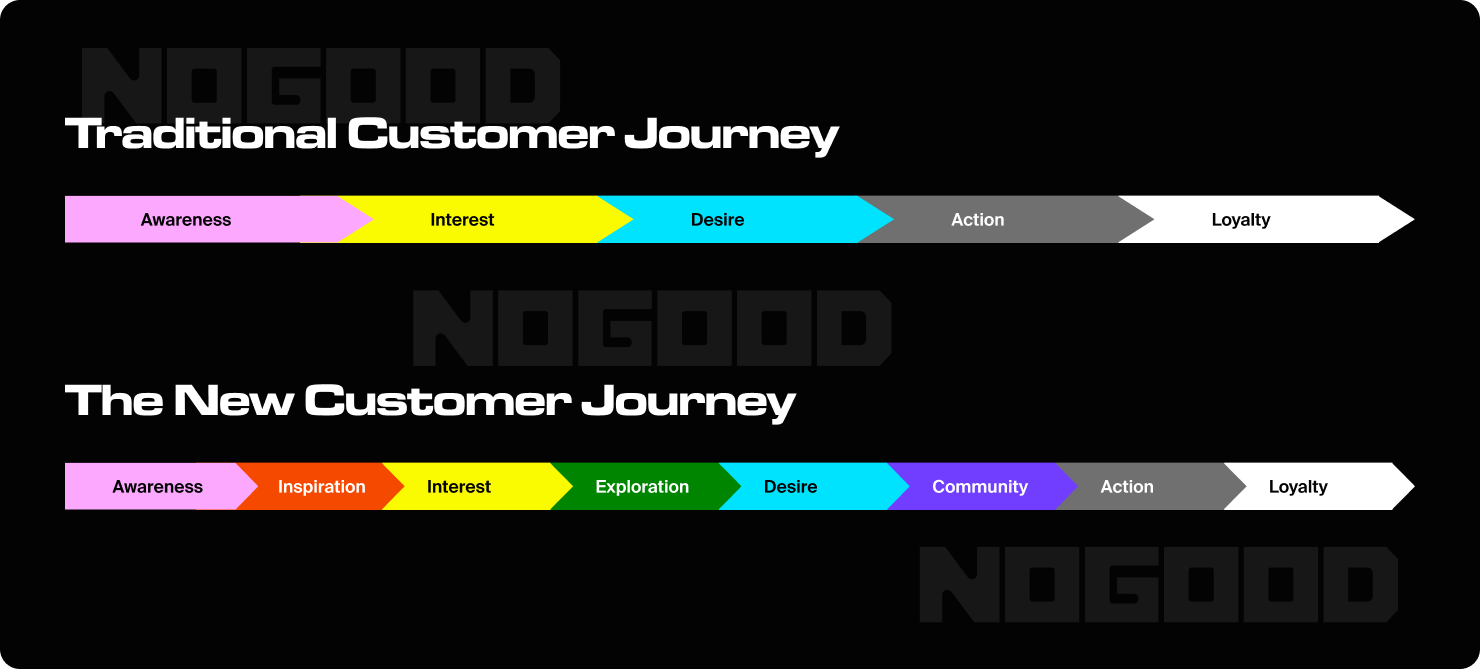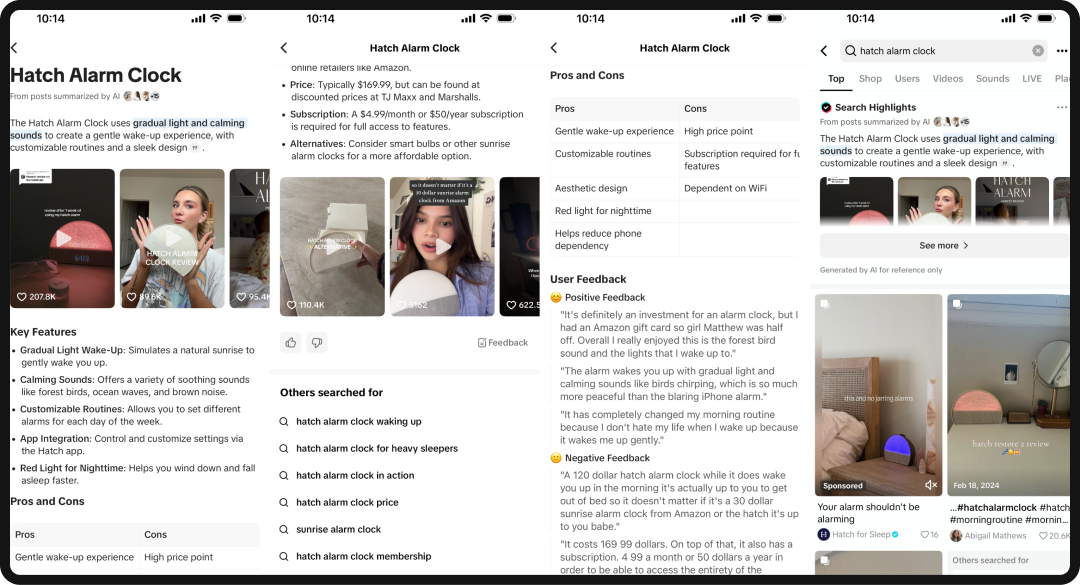Your audience is already using social media as a search engine. Dissatisfied with the quality and helpfulness of the content surfaced on traditional search engines like Google and Bing, 62% of the 18 to 24 demographic search on TikTok instead of Google.
What we’re currently witnessing is a fundamental redefinition of the way we trust the internet, prioritizing aspects like timeliness, social validation, and niche relevance over metrics like domain authority or page ranking.
What Is Social Search?
Think of social search as the 2.0 version of word-of-mouth marketing. Instead of asking a friend where to get the best pizza in town, people are now turning to TikTok, Instagram, Reddit, or YouTube to see what real people are saying, showing, and recommending. The difference is scale: one recommendation doesn’t just stay between two friends, it’s amplified to thousands or millions, all discoverable through keywords, hashtags, and algorithm-driven feeds.
Social search blends the trust of personal recommendations with the precision of algorithms. Instead of static links on a results page, discovery happens through the social graph, surfacing content from friends, creators, and communities users already trust. Real-time trends and viral content shape what rises to the top, while community signals like likes, comments, and shares act as built-in quality filters. The result is a more dynamic, personalized experience where every query reflects not just what’s popular, but what’s relevant to you based on your network, behavior, and interests.
How Does Social Search Work?
Social search relies on algorithms that combine search intent with social signals to deliver results that feel more relevant, contextual, and human. When a user types a query into the search bar on a social media platform like TikTok or YouTube, the platform factors in real-time engagement, network connections, and cultural momentum as signals for which content would be most suited to the user’s search intent. Here’s how it plays out across platforms:
Search on TikTok
TikTok’s search is powered by its recommendation engine. When you type a query, results are ranked by watch time, shares, and engagement velocity. The algorithm prioritizes recency and virality, so the top results are often trending content or creator-driven explainers that have already gained traction.
Search on Instagram
Instagram search blends hashtags, captions, and visual recognition. If you search “brunch in New York City,” the platform pulls from tagged posts, geotags, and accounts with high engagement around that topic. The Explore page also doubles as a search engine, surfacing results influenced by your browsing history, saved posts, and who you follow.
YouTube Search
YouTube search is closer to a hybrid between Google and social search. Its search relies heavily on metadata (like titles, tags, and descriptions) but is fine-tuned by engagement metrics like watch time and subscriber activity. Recommended videos in the sidebar or homepage often appear alongside search, creating a discovery loop that extends far beyond your initial query.
Search on Reddit
Reddit search operates through community-driven indexing. Queries surface posts, threads, and comments that are ranked by upvotes, recency, and subreddit relevance. Unlike other platforms, Reddit emphasizes depth and discussion, so results often look more like long-form recommendations or debates rather than quick-hit content.
Pinterest Search
Pinterest functions as a visual-first search engine, but with a social layer. Queries surface Pins based on image recognition, keywords in descriptions, and board categorization. The platform also uses collaborative signals (what people save together, repin trends, and seasonal spikes) to rank and recommend results.
Unlike TikTok or Instagram, which lean heavily on recency and virality, Pinterest emphasizes relevance and longevity: a Pin from three years ago can still surface at the top if it continues to drive saves and clicks. This makes Pinterest uniquely positioned for evergreen discovery, especially in categories like food, fashion, home, and travel.

Across all platforms, the technical backbone of social search combines three elements: content metadata (tags, captions, keywords), behavioral data (likes, shares, watch time), and network data (social graph, community activity). Together, these signals ensure that results aren’t just accurate, but also aligned with cultural context and personal relevance.
The New Playbook for Attention
The battle for attention is a rivalrous game and social search is rising to the challenge. According to The Economist, economists may soon even start to think of brainrot as a means of theft, thus modeling attention as a scarce resource alongside land, labor and capital. For a long time, that battle for attention centered around the Google SERP: who is ranking higher, who is driving the most traffic, etc. Now, the rules have changed and there’s a new player in the mix.
With social search, the environment is increasingly hostile and users are demanding a higher standard of personalization, immediacy and relevance.
The new playbook for attention operates under the assumption that discovery needs to happen at the speed of culture, meaning what works today may already feel outdated tomorrow. The SERP was relatively stable: optimize for keywords, build authority, and watch rankings compound. Social search, on the other hand, factors in relationships, sentiment, and context. The algorithm isn’t just asking “Is this accurate?” but “Is this relevant, engaging, and validated by people like you?”
That makes the system more competitive and more unforgiving. The willpower and effort it takes to click through multiple links on Google, parse long articles, and piece together information is unlikely to defeat “perfectly tuned distraction machines” like TikTok and Instagram that constantly adjust to maximize user engagement.
For brands, this means the playbook shifts from gaming a search index to proving your brand health and relevance in real time:
- Sentiment as a signal. Owned and earned conversations about your brand shape how (and whether) you show up in social search. Positive community validation is as critical as algorithmic optimization.
- Personalization is the baseline. A one-size-fits-all search experience no longer satisfies. Content must feel tailored to individual needs, preferences, and communities.
- Trust lives in the comment sections. Gen Z doesn’t just watch the video; they scroll the comments to validate it, making conversation around content just as important as the content itself.
- Going beyond vanity metrics. Views and impressions aren’t enough. What matters is whether you’re genuinely resonating with the questions and intentions behind consumer searches.
In short, the brands that thrive in the new attention economy will be those that listen as much as they publish, treating every search behavior, trend, and comment thread as a signal, and responding with relevance.
How Accurate Is the Information From Social Search?
One of the biggest critiques of social search is its accuracy; after all, TikTok isn’t built to be a fact-checking engine. But that’s also the point. People don’t flock to TikTok, Instagram, or Reddit for hard, objective truths; they go there for subjective opinions, lived experiences, and the conversations surrounding them.
This subjectivity is what gives the content value, particularly when the customer journey has now evolved to include additional steps like exploration, inspiration and community validation.

For many users, the value lies not in a definitive answer, but in the variety of perspectives. Watching a product review, scrolling through a “day in the life,” or reading dozens of comments gives richer context than a single blue link could. In this way, accuracy becomes less about factual precision and more about whether the information feels authentic, recent, and socially validated.
Platforms themselves are starting to recognize this tension. TikTok, for example, is experimenting with AI-generated summaries that group content into positive and negative perspectives, giving users a quick way to gauge sentiment without watching every video. But even with these tools, brand perception ultimately depends on who’s creating the content and what conversations surround it.

For brands, this means that maintaining accuracy is an active responsibility. If your brand isn’t proactively showing up in these conversations, others will define the narrative for you. In addition to monitoring the content created about your brand, don’t underestimate the comment section. Inaccuracies are often called out immediately, and users actively fact-check one another in real time. While messy, this ongoing dialogue creates a feedback loop of corrections and opinions that helps surface the most credible and trustworthy voices.
With this in mind, the question for many users is then less “is this accurate?” and more “how can I access the perspective and opinions that are relevant to me?”.
For many, social search isn’t about finding the single “right” answer. Its value comes from its ability to quickly surface a spectrum of opinions, experiences, and validations that make results feel more human, current, and relevant.
How to Optimize for Social Search
Optimizing for social search requires a shift in approach from traditional SEO. The focus is on creating content that aligns with how people search, share, and engage on platforms like TikTok, Instagram, and YouTube.
- Start with keyword research on social platforms. Look at trending phrases, hashtags, and autocomplete suggestions to see how users phrase their searches. This will guide both the language and the tone of your content.
- Build keywords into multiple content layers. Use them in your voiceover, captions, on-screen text, hashtags, and alt text. Each layer helps reinforce what your content is about and increases the chance of showing up in relevant searches.
- Amplify user-generated content. UGC creates social proof and increases the number of positive mentions tied to your brand. It also adds authenticity, which matters when people are searching for trustworthy recommendations.
- Stay active in cultural and trending conversations. Recency is critical for visibility in social search. Joining relevant conversations and responding to audience questions keeps your brand present in real time.
What’s Next for Online Discovery: Scale vs. Intimacy
The landscape of discovery is moving in two directions at once. On one side, we’re seeing the rise of closed brand communities and trusted content curators, where people go to escape algorithm fatigue and engage in smaller, more intentional spaces. On the other, platforms like Google are scrambling to keep pace by crawling social content, attempting to reassert themselves as the default starting point for search.
Reddit is emerging as a critical player in this shift. As one of the largest community-driven ecosystems online, it functions as a massive comment section for the internet, where people validate, challenge, and expand on what they see elsewhere. This kind of peer-to-peer curation reflects a broader shift: authority is no longer handed down from a single platform, but built through the collective voice of communities.
Underlying all of this is a continued erosion of trust. Users don’t just want information; they want context, transparency, and proof that what they’re seeing is relevant and authentic. This means that the silos between SEO and organic social are breaking down; search insights can fuel content ideation, while social content itself is being indexed and surfaced directly in Google results. Together, they create a feedback loop that reflects what people are actively searching for, saying, and sharing.
The future of discovery is no longer defined by linear paths but by a fragmented, multi-layered ecosystem where authority and attention shift fluidly between platforms. Success will belong to brands that understand discovery as a networked system where SEO, social signals, and community sentiment constantly reinforce each other. Winning in this landscape requires moving beyond visibility alone to actively managing perception, cultivating advocacy, and shaping the conversations that ultimately determine whether people trust and choose you.






